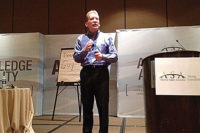
Bill
Kenny, ASA President (left) presents Frank Nisonger, ASA Chairman of the Board,
with the traditional crystal gavel in appreciation for his many years of volunteer
service. Photos courtesy of ASA
Wholesalers and manufacturers displayed an upbeat attitude at last month’sAmerican Supply Association’s annual convention despite the still-struggling economy and uncharacteristically rainy weather in Las Vegas. The meeting, held Sept. 13-16 at the Bellagio hotel, drew substantially more wholesaling companies and manufacturers than last year’s meeting in Chicago.
The number of wholesaling companies rose to 84, up to 36% from 2010. Manufacturers at the meeting grew to 64, up 32%. Overall, attendance climbed to 498 people, an increase of 36% from last year.
With a theme of “ALL IN – Cashing In On The Economy,” the convention featured speakers who gave their outlook for the PHCP industry and the country in general. New this year was a format that offered wholesalers and manufacturers opportunities to meet face to face during conference appointments and tabletop sessions.
Other highlights of the meeting included networking receptions, the unveiling of new ASA educational programs and the introduction of Scott Weaver as incoming ASA president.

Representing the future of the industry at the Young Executives
reception are Ben Potgeter, Etna Supply; Pam Mouton, Coburn Supply Co.; Angie
Visner, Etna Supply; and Kevin Roche, Porter Pipe and Supply.
Economic Outlook
Columnist Gene Marks, economist Lowell Catlett and TV commentator Chris Wallace agreed in separate presentations that identifying a recovery has been difficult with 7 million people unemployed and 2011 economic growth at 1%.“That really stinks,” Marks told ASA members. “We’re not growing enough. How do we grow our businesses when everyone is only at 1% growth?”
Corporate spending levels still are very low, he said, which is holding back growth. Many companies are profitable, however, and Marks named three types that are making money:
- Commodity businesses that benefit from the rising prices
of raw materials;
- Companies that are innovative in how they cut back on expenses;
and
- Export companies.
Utilities have been growing too, Marks said, due to energy prices and the rise in alternative energy sources. He added that companies should not be too quick to blame Washington for their financial woes.
“Smart people put aside emotions when they talk about government and politics,” he said. “They deal with the facts.”
Marks listed five trends that could help ASA members become more profitable.
1. Follow the money.Companies should go after industries that are growing. These include education, health care, technology, infrastructure and alternative energy.
2. Right size your company.This does not have to mean layoffs. More companies are outsourcing operations, such as their phone service, to specialists. They’re also allowing more employees to work from home, which takes up less space and could lower rent.
3. Follow the Fed.Companies should keep an eye on what the Federal Reserve Board is doing with interest rates. Taking short-term debt and making it long-term debt may make sense.
4. Consider the cloud.Cloud computing allows employees to do what they need to do wherever they want to do it. It can operate off a laptop, smartphone or iPad.
5. Have a few favorite metrics.Business people can get an idea of where the economy is going by regularly following metrics as diverse as the Baltic Dry Index, Consumer Confidence Index, Divorce Index and Underwear Index. Some like to track auto sales or the price of steel and copper. Others have a favorite economist whose blog they read.
In his presentation, Catlett pointed out that an optimist is 56% more productive than a pessimist is. He said the U.S. economy has strengths that often go unmentioned.
Baby boomers, for example, make 80% more income than their parents did. Americans do much better with savings than statistics indicate.
“We calculate what we have in savings,” he said. “We don’t calculate what we have in retirement.”
In today’s economy, companies have to be ready to make changes, Catlett noted.
“Who’s prepared to make changes the fastest will survive,” he said. “Will you always be right? No!
“Remember that no general ever goes into battle without a plan. And no plan ever survives a battle.”
Wallace’s comments took on a more political tone. He said President Obama’s recently announced jobs plan is intended to avoid a double-dip recession.
“I think the GOP will go for parts of Obama’s jobs plan because they don’t want to appear as obstructionist,” Wallace said. “As bad as Obama’s poll numbers are, Congress’ numbers are worse.”
Looking ahead to next year’s presidential election, he said less regulation, lower taxes and the repeal of health-care legislation will be Republican issues regardless of who the candidate is.

Manufacturers
and distributors attending the Industrial Piping Division reception include Rex
Martin of NIBCO (far left).
Education and Forecasting
Mark Hanley of Moore Supply/Hajoca outlined ASA’s education initiatives during the meeting. These include ASA University and ASA Online.New for ASA Online are two programs: College of Sales/Sales Management and College of Leadership/Executive Management. Also on the way is an Individual Training Solutions program.
In his speech, incoming ASA President Weaver of APR Supply recapped the functions of the association as networking, education, advocacy and benchmarking. Forecasting will become the next important function, he said.
“My vision is that ASA must become indispensible through forecasting,” Weaver said. “ASA must become the repository of financial data in the wholesale industry.”



